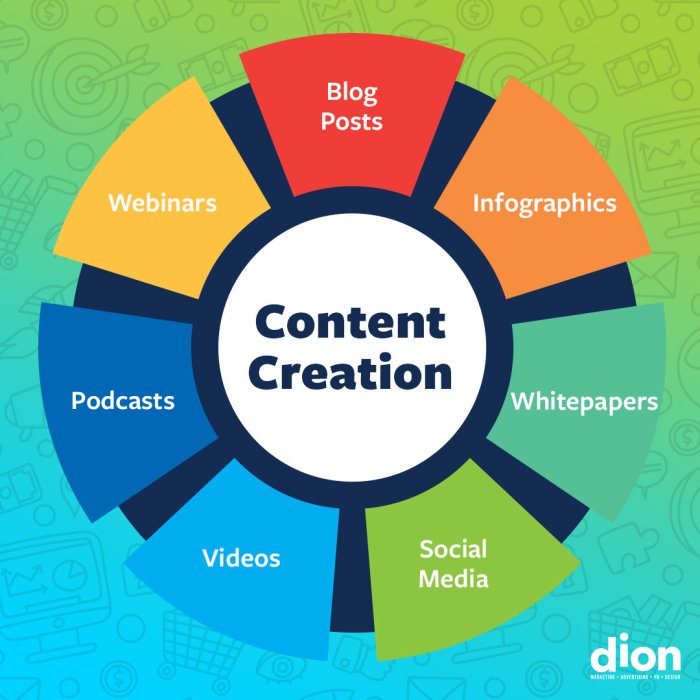Creating Content for Millennials kicks off with a bang, diving into the world of the younger generation with a fresh and trendy perspective. Get ready to explore their preferences, habits, and the secrets to capturing their attention through content creation.
Understanding Millennials

Millennials, also known as Generation Y, are individuals born between 1981 and 1996. They are characterized by their digital savvy nature, tech reliance, and desire for authentic and personalized experiences.
Millennials Characteristics
- Prefer digital communication over face-to-face interactions.
- Value experiences over material possessions.
- Seek work-life balance and flexibility in their careers.
- Embrace diversity and social causes.
Millennials Preferences and Habits
- Prefer consuming content on mobile devices, especially through social media platforms like Instagram and TikTok.
- Enjoy interactive and engaging content formats such as videos, memes, and stories.
- Appreciate authenticity and transparency from brands and influencers they follow.
Millennials Value System
- Place importance on sustainability and environmental consciousness.
- Value inclusivity and representation in media and advertising.
- Prioritize mental health and self-care practices.
Millennials vs. Other Generations
Millennials differ from previous generations in their approach to consuming content by valuing personalized and interactive experiences. They are more likely to seek out diverse voices and perspectives in the content they engage with, driving the need for authenticity and relatability in marketing strategies.
Content Preferences of Millennials

When it comes to creating content for millennials, it’s essential to understand their preferences to ensure engagement. Millennials are drawn to various types of content, with video, social media, and blogs being highly popular platforms for reaching this demographic. These mediums allow for quick consumption and easy sharing, making them ideal for connecting with millennials on a personal level.
Authenticity and Relatability
Authenticity and relatability are key factors in creating content that resonates with millennials. They value genuine, transparent content that reflects real experiences and emotions. Millennials are more likely to engage with content that they can relate to on a personal level, whether it’s through shared interests, struggles, or aspirations. By being authentic and relatable, content creators can build trust and loyalty with this audience.
Visual Elements and Storytelling
Visual elements play a crucial role in capturing the attention of millennials. Eye-catching graphics, videos, and images can enhance the overall appeal of content and increase engagement. Millennials are visually-oriented and respond well to content that is aesthetically pleasing and easy to consume. Additionally, storytelling is a powerful tool for connecting with millennials on an emotional level. Compelling narratives and personal anecdotes can create a strong connection with this audience, making them more likely to engage and share the content with others.
Platforms for Reaching Millennials: Creating Content For Millennials
When it comes to reaching millennials, understanding the platforms they frequent is key. From Instagram to TikTok to YouTube, each platform offers unique opportunities to engage with this demographic in different ways.
Popular Social Media Platforms
- Instagram: Known for its visual focus, Instagram is a popular platform among millennials for sharing photos and videos. Utilize features like Stories and Reels to create engaging content that resonates with this audience.
- TikTok: With its short-form video format and viral challenges, TikTok has quickly become a favorite among millennials. Create fun and relatable content that aligns with TikTok trends to capture the attention of this audience.
- YouTube: As a platform for longer-form video content, YouTube appeals to millennials looking for in-depth information and entertainment. Consider creating tutorials, vlogs, or product reviews to engage with this audience on YouTube.
Content Consumption Habits
- Visual Content: Millennials prefer visually appealing content that is easy to consume on the go. Use eye-catching graphics, videos, and images to capture their attention.
- Authenticity: Millennials value authenticity and transparency in the content they consume. Be genuine and relatable in your messaging to build trust with this audience.
- Interactive Content: Engage millennials through interactive content such as polls, quizzes, and Q&A sessions. Encourage participation and feedback to foster a sense of community.
Optimizing Content for Platforms
- Platform-Specific Content: Tailor your content to fit the format and audience of each platform. What works on Instagram may not work on TikTok, so customize your content accordingly.
- Consistent Branding: Maintain a consistent brand identity across all platforms to establish a cohesive online presence. Use similar visuals, tone, and messaging to reinforce your brand image.
- Data Analytics: Monitor and analyze the performance of your content on different platforms to understand what resonates with millennials. Use this data to optimize future content strategies.
Creating Engaging Content for Millennials
Millennials are known for their short attention spans and desire for interactive and shareable content. To effectively engage this audience, content creators need to think outside the box and implement strategies that resonate with them on a personal level.
Importance of User-Generated Content and Influencer Collaborations
One of the most effective ways to engage millennials is through user-generated content. This involves encouraging your audience to create and share their own content related to your brand or product. Millennials value authenticity and are more likely to trust recommendations from their peers over traditional advertising.
- By incorporating user-generated content into your strategy, you can create a sense of community around your brand and foster a deeper connection with your audience.
- Furthermore, collaborating with influencers who have a strong following among millennials can help amplify your message and reach a wider audience.
- Influencers can add credibility to your brand and help create buzz around your content, making it more shareable and engaging.
Examples of Successful Content Campaigns
Several brands have successfully engaged millennials through creative and innovative content campaigns. These campaigns have resonated with millennials by tapping into their values, interests, and preferences.
- Red Bull’s Stratos Jump: Red Bull’s live stream of Felix Baumgartner’s record-breaking skydive captured the attention of millennials worldwide. The extreme sports spectacle appealed to millennials’ sense of adventure and adrenaline, making it highly shareable on social media.
- Snapchat’s Geofilters: Snapchat’s user-generated geofilters allow millennials to personalize their photos and videos with location-specific stickers. This interactive feature has been a hit among millennials, driving user engagement and brand awareness.
- Dove’s Real Beauty Campaign: Dove’s campaign promoting body positivity and self-acceptance struck a chord with millennials, who value authenticity and inclusivity. The campaign encouraged users to share their own stories and experiences, sparking a conversation around beauty standards.
Adapting to Changing Trends
Staying updated with current trends is crucial to keep content relevant to millennials. This generation is constantly evolving, and their interests are shaped by the latest memes, challenges, and viral trends. Adapting to these changes ensures that your content remains engaging and resonates with millennials.
Impact of Meme Culture, Challenges, and Viral Trends, Creating Content for Millennials
- Meme Culture: Memes have become a language of their own for millennials, with humor and relatability being key factors. Incorporating popular memes into your content can help establish a connection with this audience.
- Challenges: Social media challenges often go viral among millennials, creating opportunities for brands to join the conversation and engage with their audience in a fun and interactive way.
- Viral Trends: Keeping an eye on what’s trending online allows you to capitalize on viral moments and create content that is timely and shareable.
Leveraging Pop Culture References and Timely Events
- Pop Culture References: Referencing popular TV shows, movies, music, and celebrities can add a relatable and current touch to your content, making it more appealing to millennials.
- Timely Events: Tapping into current events and cultural moments can help your content feel relevant and in-the-moment. Whether it’s a holiday, a trending topic, or a social movement, incorporating these elements can make your content more engaging.












